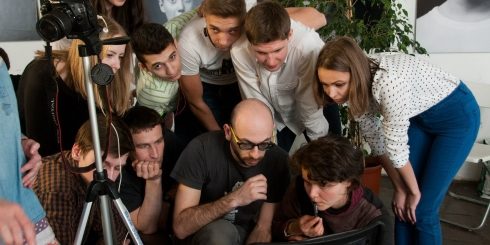HUMRA – Human Rights Animation
What rights do “humanoids” possess?

In short animated films, youngsters at HUMRA express what moves them about human rights. | Photo: Ekaterina Schraga
What does it mean to be human? And how do we protect the dignity of individuals? In the Goethe-Institut project HUMRA – Human Rights Animation, young people grappled artistically with human rights issues. In cooperation with Russian comic artists, they created short, thought-provoking animated films.
The teenagers from Russia, Ukraine, Georgia and Belarus met in St Petersburg for animation workshops. Together with human rights organizations in these countries, they were able to discover a shared language in a politically difficult time marked by territorial conflicts.
“For your safety, put on protective cages when leaving home”
 “Who makes society’s rules?”
| Photo: Ekaterina Schraga
In St Petersburg, teens between the ages of 12 and 16 worked on the film Who is in Charge Here? Together with artists and filmmakers, they devised the script and the film during a one-week workshop. The film has already been shown and received awards at a number of festivals.
“Who makes society’s rules?”
| Photo: Ekaterina Schraga
In St Petersburg, teens between the ages of 12 and 16 worked on the film Who is in Charge Here? Together with artists and filmmakers, they devised the script and the film during a one-week workshop. The film has already been shown and received awards at a number of festivals.
Throwing gullibility overboard
Instructors from the St Petersburg animation studio Da produced the cartoon Overboard with young people. It uses irony and wit to illustrate that not everything (young) people are told is true. Made lovingly by hand, the film encourages people to reflect and has a happily unexpected ending.HUMRA. A story about humanz rights
The Russian comic artist Heehoos collaborated with the Russian studio Konstantin to produce a professional animated series. On the far-away and forgotten planet HUMRA, the main character Cheggi encounters the disgraced historian Pankrat and courageous Yooka. Together, they battle against the repressive Stabilina state machinery.Based on the animated series, Heehoos and human rights experts created seven educational episodes on topics such as “the state and minorities” and “protection of privacy.”
You can watch another six episodes here.